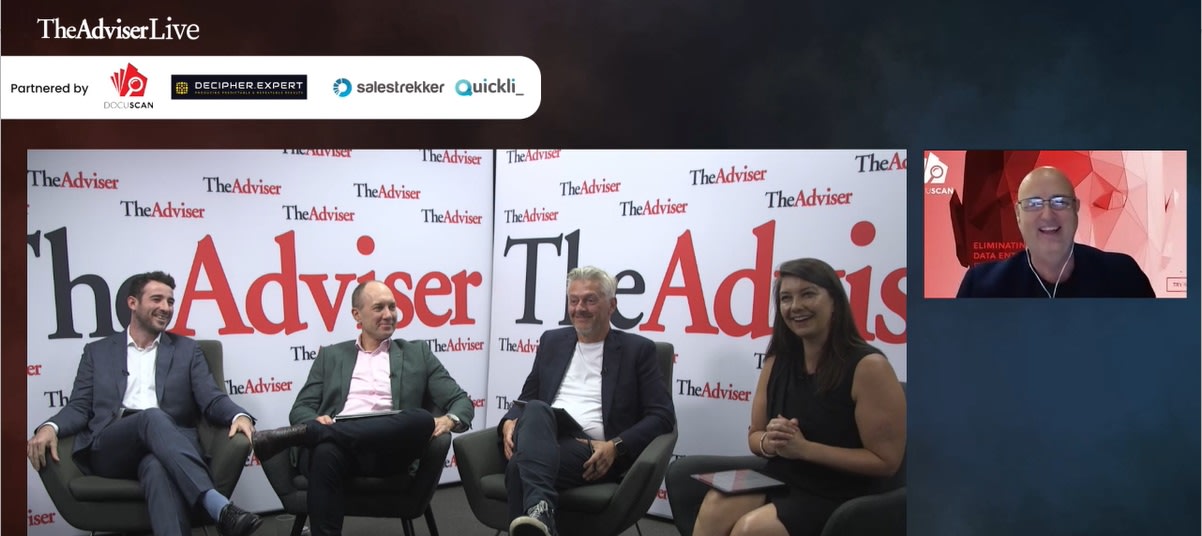
Brokers could free up hours of time, standardise processes, and bring in more business by better utilising technology, according to a panel of tech specialists.
Speaking on The Adviser Live webcast – the tech tools making brokers’ lives easier on Tuesday (21 November), four leaders in the broker technology space outlined the case for brokers to be better utilising their existing tech platforms and using complementary tech alongside it to help them bring in more revenue and enhance their service offerings.
Focusing on a broker’s main piece of technology – their customer relationship management (CRM) system – Dalibor Ivkovic, chief executive of CRM provider Salestrekker, outlined that many brokers still hadn’t harnessed their systems to increase the number of settlements per month or streamline their post-settlement contact or annual reviews.
Mr Ivkovic explained: “We looked at the broker stats (and you probably saw them from MFAA recently) and they’re not that flash. [They] do two and a half settlements a month. About 15 per cent do regular reviews. Only about 30 per cent diversify. And it takes about 15+ work hours to process a loan. That needs to improve.”
He flagged that the incoming version of Salestrekker (Salestrekker 2.0) aims to act as a broker’s single technology platform, forgoing the need for brokers to have multiple systems for origination, workflow tracking, marketing, and servicing.
It aims to save brokers time and money by digitising and centralising data sources, while accelerating growth by streamlining, automating, and managing tasks in one system.
He added that it will also provide “dramatic change” by bringing decisioning inside of the platform, enabling lenders to utilise APIs to integrate directly into Salestrekker.
Mark Kevin, founder and consultant at Decipher.Expert (an off-the-shelf configuration of CRM platform BrokerEngine) and principal at Mortgage Advice Bureau Sydney, noted that when he first joined the broking industry, he wanted to create a “super efficient” operation.
As such, he spent “hundreds of hours” delving into the BrokerEngine CRM and customising it to create his blueprint to meet the needs of his rapidly scaling brokerage and create a hyper-efficient blueprint that other brokers could follow.
He said that he automated and templated any process he repeats day to day and created advanced checklists and additional email templates and interview files that his other brokers could follow, thereby systemising the broking process.
He explained that the Decipher.Expert configuration is therefore designed to “compress the potentially hundreds of hours that a brokerage principal would need to do to invest in getting their own blueprint right for them” into four to eight hours.
The Sydney-based broker outlined that as well as harnessing existing broker tech, he was also embracing tech stacking outside of his CRM, including repricing tech Sherlok; document reading and signing tech like DocuSign, DocuScan, and Adobe Sign; calendar management systems Calendly; and servicing platform Quickli, among others. These all contributed to time efficiencies and a more seamless interaction for clients.
Angus Keatinge , the co-founder of Quickli, flagged that the platform was working to help brokers tackle the servicing challenge, which is particularly difficult at the moment given changing rates and buffers.
The platform, built by Mr Keatinge and broker Eric Dill, focuses on solving the critical issue of serviceability in the broking industry by bringing together more than 30 lender calculators into one interface and eliminating guesswork from the preliminary assessment by checking a borrower’s borrowing capacity against lender policy.
He said: “When servicing is tight, brokers can’t lean on their gut; it’s not just about picking policy out of a hat … they really need to do that in-depth due diligence to be sure that they’re sending the deal to the right place. And so that was how we designed our platform: to help brokers go really deep with that research and to do it with confidence as well … That element of trying to take the guesswork out of the preliminary assessment is really key to what we’ve done.
“In the two years that we’ve been live, the mortgage landscape has changed dramatically several times. When rates were rising, we pulled in some features to help brokers understand how that was going to impact prospective clients. And now, with lenders bringing in 1 per cent servicing policy ... We’re bringing in features to help brokers really nail those niche questions and get things over the line with more confidence.
“For that core servicing problem, being able to be reactive and to respond to market conditions to help brokers ... and we’re finding a lot of brokers are really utilising Quickli in that initial sales phase of their process, those initial conversations, to really bolster confidence with their client that they’re in good hands.”
Outside of servicing, another area that takes up a large amount of time and opens up risks to brokers is document collection.
Brett Spencer, CEO of AI-driven document capture software DocuScan, said the platform aims to help brokers detect fraud in documents and eliminate manual data entry.
It identifies potential fraudulent activities within documents, utilising 156 different entry points to spot discrepancies, such as cross-referencing ABNs, verifying tax calculations, and examining document metadata.
DocuScan also converts various documents (financial, trust papers, contracts, etc) into organised datasets and enables brokers to upload documents into the platform, which then generates structured datasets usable in CRM, broker, and other relevant platforms.
The technology aims to save brokers a substantial amount of time and protect their reputation by ensuring the authenticity of financial documents.
He said: “We still fail, as an industry, to realise that the great Australian dream is to own a home and a consumer will do anything and everything to buy their home, including falsifying a lot of information … And that’s where we save these businesses. We don’t want a loan going through an aggregator to a lender where a processing person has not picked up that there is a slightly different font level in a set of bank statements or there’s a misalignment in a payslip or the calculations haven’t been correct.”
According to Mr Spencer, DocuScan can help save between 40 and 80 per cent of the data collection time, but the reputational savings are innumerable.
Didn’t catch the live webcast? You can catch up on demand to watch The Adviser Live webcast – the tech tools making brokers’ lives easier here.
[Related: Tech stacking – the tech tools making brokers’ lives easier]
 Login
Login










JOIN THE DISCUSSION